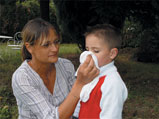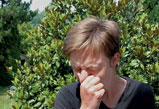Nearly 25% of the French population suffers from respiratory allergy. Several factors can be responsible of these symptoms. They can be classified in 3 categories:
• The internal environmental factors: it is about all the potential allergens inhaled with the indoor air of premises: mites, moulds, hair of cat, hair of dog, etc…
• The outside environmental factors: it is about all the potential allergens inhaled with the outside air: pollens, moulds.
• The factors of atmospheric pollution: there are triangular relations between pollution, pollens and allergy.
The pollution can act at the same time on pollens by modifying their outside biochemical structure and their allergenicity, and on respiratory mucous membranes of the patient by modifying its immunological sensibility to pollen grains.
How appear a pollinose?
The seasonal allergic rhinitis: narrow-minded nose, sneezes, runny nose and itches.
The seasonal allergic conjunctivitis: red eyes which prick, with sensation of sand in eyes.
Small pollens, which can penetrate to bronchi, can provoke asthma attacks: decrease of the breath, the bronchial whistlings, the often night-persistent cough. Oedemas and nettle rash are more rare.
All these symptoms are improved by the rain and aggravated by the wind. They are more important outside than inside.
Pollens and allergy
Pollens: the male grains of pollens contribute to the development of the vegetation which assures the regeneration of the oxygen and have an essential role in the food.
However, for at least 20% of the population, they are responsible for allergic reactions, generally seasonal, called "hay fevers".
The increase of this type of allergy, which would have doubled in 10 years, justifies monitoring of the quality of the air.
It is the Aerobiology (or Aeropalynologie) that studies pollens spread by the wind of the anemophilous plants.
All the pollens are not dangerous:
To provoke an allergic reaction, it is necessary that:
• the pollen of tree or herbaceous is emitted in great quantities. It is the case of anemophilous plants like grasses, ragweed, cypress, birch. Pollens of plants entomophilous as the mimosa (reproduction and transport by insects) can provoke reactions of proximity.
• the pollen is small-sized. The grains of pollen will stay more in the atmosphere, and can go through bigger distances if they are small and light. For that reason we shall find allergenic pollens as well in the cities as in the countryside.
• it has a strong allergy potency. It can release its protein particles responsible for the raising sensitization.
Conclusion
Other factors can intervene: the simultaneous presence of several allergenic pollens, the atmospheric pollution, the existence of cross-reactions between pollens of the same family or with food. Finally, it is needed a particular genetic ground to develop this allergy: the atopic ground.


